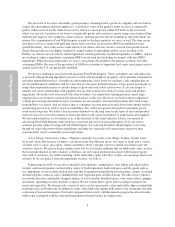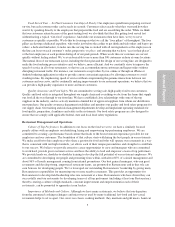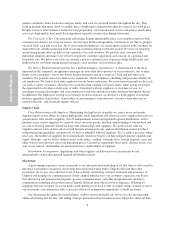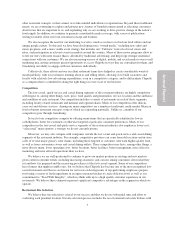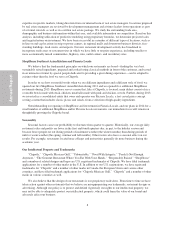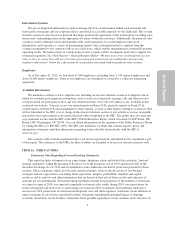Chipotle 2013 Annual Report Download - page 16
Download and view the complete annual report
Please find page 16 of the 2013 Chipotle annual report below. You can navigate through the pages in the report by either clicking on the pages listed below, or by using the keyword search tool below to find specific information within the annual report.
ingredients escalated markedly at various points during 2013 and we expect that there will be additional pricing
pressures on some of those ingredients, including avocados, beef, dairy and chicken during 2014. We could also
be adversely impacted by price increases specific to meats raised in accordance with our sustainability and
responsibility criteria or other food items we buy as part of our Food With Integrity focus, the markets for which
are generally smaller and more concentrated than the markets for commodity food products. Weather related
issues, such as freezes or drought, may also lead to temporary spikes in the prices of some ingredients such as
produce or meats. For instance, two years of drought conditions in parts of the U.S. have resulted in significant
increases in beef prices during late 2013 and early 2014. Increasing weather volatility or other long-term changes
in global weather patterns, including any changes associated with global climate change, could have a significant
impact on the price or availability of some of our ingredients. Any increase in the prices of the ingredients most
critical to our menu, such as chicken, beef, cheese, avocados, beans, rice, tomatoes and pork, would adversely
affect our operating results. Alternatively, in the event of cost increases with respect to one or more of our raw
ingredients, we may choose to temporarily suspend serving menu items, such as guacamole or one or more of our
salsas, rather than paying the increased cost for the ingredients. Any such changes to our available menu may
negatively impact our restaurant traffic and comparable restaurant sales, and could also have an adverse impact
on our brand.
Our business could be adversely affected by increased labor costs or difficulties in finding the right
employees for our restaurants and the right field leaders.
Labor is a primary component of our operating costs, and we believe good managers and crew are a key part
of our success. We devote significant resources to recruiting and training our general managers and crew.
Increased labor costs due to factors like additional taxes or requirements to incur additional employee benefits
costs, including the requirements of the Patient Protection and Affordable Care Act, or the Affordable Care Act,
(discussed further under “Regulatory and Legal Risks—The effect of recent changes to U.S. healthcare laws may
increase our healthcare costs and negatively impact our financial results,”), as well as competition, increased
minimum wage requirements, paid sick leave or vacation accrual mandates, and any changes in our restaurant
staffing structure would adversely impact our operating costs. Our success also depends in part on the energy and
skills of our employees and our ability to hire, motivate and keep qualified employees, especially general
managers and crew members. As we grow, we believe we will need to promote or hire additional top-performing
field leaders to ensure we hire and motivate good managers and crew, and it may be difficult to identify and keep
those field leaders. Our failure to find and keep enough employees who are a good fit with our culture could
delay planned restaurant openings, result in higher employee turnover or erode our employee and restaurant
cultures, any of which could have a material adverse effect on our business and results of operations. Restaurant
operators have traditionally experienced relatively high employee turnover rates. Any increase in our turnover
rates for managers or crew could be costly and could negatively impact our operations.
Various states in which we operate are considering or have already adopted new immigration laws, and the
U.S. Congress and Department of Homeland Security from time to time consider or implement changes to
Federal immigration laws, regulations or enforcement programs as well. Changes in immigration or work
authorization laws may increase our obligations for compliance and oversight, which could subject us to
additional costs and make our hiring process more cumbersome, or reduce the availability of potential
employees. Although we require all workers to provide us with government-specified documentation evidencing
their employment eligibility, some of our employees may, without our knowledge, be unauthorized workers. We
currently participate in the “E-Verify” program, an Internet-based, free program run by the U.S. government, to
verify employment eligibility for all employees throughout our company. However, use of E-Verify does not
guarantee that we will properly identify all applicants who are ineligible for employment. Unauthorized workers
may subject us to fines or penalties, and we could experience adverse publicity that negatively impacts our brand
and may make it more difficult to hire and keep qualified employees. For example, following an audit by the
Department of Homeland Security of the work authorization documents of our restaurant employees in
Minnesota during 2010, we lost approximately 450 employees, resulting in a temporary increase in labor costs
and disruption of our operations, including slower throughput, as we trained new employees, as well as some
degree of negative publicity. The resulting broad-based civil and criminal investigations by the U.S. Attorney for
14
Annual Report


